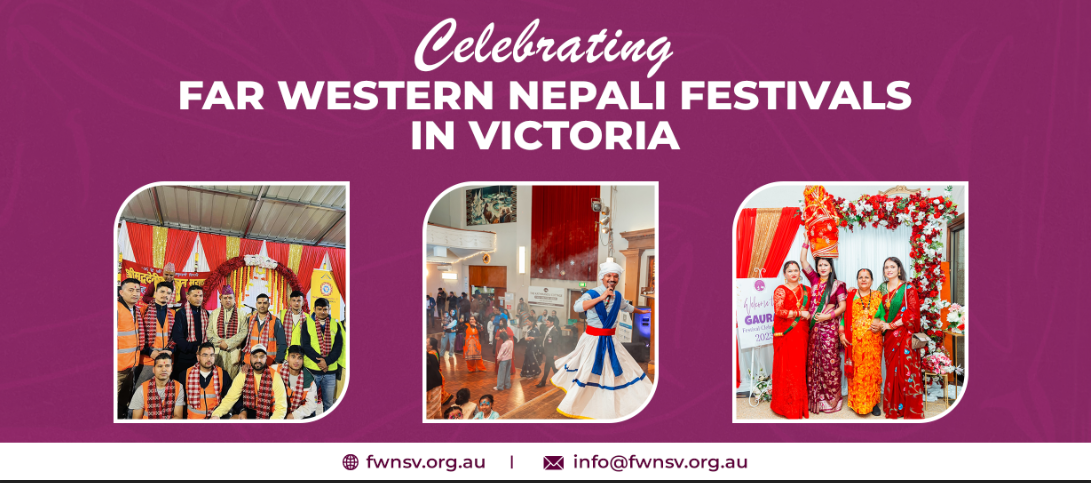Victoria, Australia, is a melting pot of cultures where people from diverse backgrounds come together to share their unique traditions. Among these vibrant communities is the Far Western Nepali community, which has brought its rich cultural heritage to Australian shores. One of the most significant aspects of this heritage is the celebration of traditional festivals. These festivals not only serve as a link to the homeland but also foster a sense of belonging and community spirit among Nepali immigrants. In this blog, we will explore how the Far Western Nepali community celebrates their traditional festivals in Victoria.
Dashain: The Festival of Victory
Dashain is the longest and most anticipated festival among Nepalis, celebrated with immense enthusiasm and zeal. It symbolises the victory of good over evil, commemorating the triumph of the goddess Durga over the demon Mahishasura. For the Far Western Nepali community in Victoria, Dashain is a time to gather, reconnect, and celebrate shared cultural values. The celebrations typically begin with the setting up of the ‘Ghatasthapana,’ marking the start of the festival. Community members plant barley seeds in a sand-filled pot, which grows into Jamara, an essential element of the Dashain ritual. Over the next ten days, families visit temples, perform rituals, and offer prayers to goddess Durga. The highlight of Dashain is the ‘Tika’ ceremony on the tenth day. Elders bless younger family members by placing a mixture of rice, yoghurt, and vermilion on their foreheads, accompanied by Jamara. This ritual symbolises the transfer of blessings and good fortune. In Victoria, community halls and private homes become venues for large gatherings where this tradition is upheld with great respect and joy. Delicious feasts, traditional music, and dances make the celebration even more vibrant.
Tihar: The Festival of Lights
Closely following Dashain is Tihar, also known as the festival of lights. Tihar is unique in celebrating animals, particularly crows, dogs, and cows, which are revered and worshipped on different days. The festival culminates with Bhai Tika, a special day dedicated to the bond between brothers and sisters. In Victoria, Tihar is celebrated with an array of lights, colours, and traditional rituals. Homes are decorated with oil lamps, candles, and colourful rangolis. The Far Western Nepali community gathers to perform the ‘Laxmi Puja,’ worshipping the goddess of wealth and prosperity. The night sky lights up with fireworks, and the atmosphere is filled with joy and excitement. Bhai Tika is particularly significant, where sisters apply tika on their brothers’ foreheads, pray for their long life, and exchange gifts. This day reinforces family bonds and is celebrated with heartfelt emotions and elaborate feasts. The Far Western Nepali community in Victoria ensures that these traditions are passed down to younger generations, preserving the essence of Tihar.
Maghe Sankranti: Welcoming the Harvest
Maghe Sankranti marks the transition of the sun into the zodiac sign of Capricorn, signalling the end of the winter solstice and the arrival of longer days. It is a harvest festival celebrated with a variety of traditional foods and rituals. For the Far Western Nepali community in Victoria, Maghe Sankranti is a time to come together and enjoy delicacies such as ‘Til ko laddu’ (sesame seed sweets), ‘Chaku’ (molasses), ‘Ghee,’ and ‘Tarul’ (yam). These foods are believed to provide warmth and energy during the cold season. The community organised gatherings where members share meals, exchange stories, and engage in traditional dances and music, keeping the festive spirit alive.
Gaura Parva: A Unique Regional Festival
Gaura Parva is a significant festival for the Far Western region of Nepal, celebrated in honour of goddess Gauri, the wife of Lord Shiva. This festival is unique to this region and involves intricate rituals and dances known as ‘Deuda.’ In Victoria, the Far Western Nepali community ensures that Gaura Parva is celebrated with its traditional fervour. Women dress in traditional attire, perform the Deuda dance, and participate in rituals that invoke the blessings of goddess Gauri for marital bliss and prosperity. The festival fosters a deep sense of cultural pride and unity among the community members.
Bispati/Bishow Parava
Bishu Parva/Bispati is a festival celebrated in the Far Western region of Nepal. It falls on the first day of Nepali New Year, which is Baishak first. This festival is considered a day of new beginnings and purification. The word “Bishu” is derived from the word “bish,” which means poison, and “Parva” (festival in Nepali) signifies washing away of poison (i.e., impurities) and starting fresh.
Significance of These Celebrations The celebration of these festivals in Victoria is more than just a cultural obligation for the Far Western Nepali community. It is an essential means of preserving their identity and passing on their rich heritage to future generations. These festivals provide an opportunity for the community to come together, support each other, and create a home away from home. By celebrating these festivals, the Far Western Nepali community contributes to the multicultural landscape of Victoria. They share their traditions, foods, music, and dances with the broader Australian society, promoting cultural understanding and appreciation. These celebrations also help younger generations connect with their roots, ensuring that their heritage remains vibrant and relevant. The Far Western Nepali community in Victoria has successfully preserved and promoted its cultural heritage through the celebration of traditional festivals. Dashain, Tihar, Maghe Sankranti, and Gaura Parva are not just events on the calendar; they are vibrant expressions of identity, faith, and unity. These celebrations bring joy, strengthen family bonds, and enhance community spirit, making a significant contribution to the multicultural fabric of Victoria. As we look forward to future celebrations, it is essential to continue supporting and participating in these cultural events. They remind us of the importance of diversity, respect, and togetherness in creating a harmonious society. By celebrating our traditions and sharing them with others, we build bridges of understanding and friendship that enrich our lives and the communities we live in.
For more information and updates on upcoming festivals and community events, follow FWNSV on the Facebook page.
